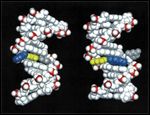Study Shows Relatively Small Portion of Second Cancers Linked to Radiotherapy
A long-term and large-scale retrospective study of cancer patients who have undergone radiotherapy show that only a small portion of secondary cancers develop due to radiotherapy treatments.
A long-term and large-scale retrospective study of cancer patients who have undergone radiotherapy show that only a small portion of secondary cancers develop due to radiotherapy treatments. Researchers at the National Cancer Institute in Bethesda, MD and the University of Texas MD Anderson Cancer Center collaborated on the study, which was published online ahead of print in Lancet Oncology on March 30, 2011 (DOI:10.1016/S14702045(11)70061-4).

Structures of DNA damaged by the carcinogenic aromatic amine 2-aminofluorene (AF)
Radiotherapy uses high-energy to kill cancer cells by damaging their DNA. However, the radiation can damage the DNA of normal cells, either killing them or causing mutations. While radiotherapy methods have become more streamlined, allowing targeting of specific cancer regions with minimal damage to normal tissue, radiotherapy does still have side effects and a risk of normal cells acquiring novel mutations that may be cancer-causing.
More than half of cancer patients receive radiotherapy during the course of their treatment and these patients are surviving longer as cancer survival rates are improving overall. The study authors addressed whether solid-cancer patients had an increased long-term risk of secondary cancer development. The study used the US Surveillance, Epidemiology and End Results (SEER) cancer database and analyzed of patients 20 years old and over who were diagnosed with a primary solid malignancy between 1973 and 2002. The researchers analyzed data from 647,672 cancer patients who were 5-year survivors. Patients were followed for an average of 12 years.
The study found that 9% of the cohort developed a second solid cancer with a small relative risk of developing a second cancer that was associated with radiotherapy. The risk was highest for organs that received higher doses of radiation (more than 5 Gy), decreased with the age at diagnosis, and increased with time since the diagnosis. Overall, the authors estimated that 3266 patients (8%) developed a second solid cancer that could be related to their radiation treatment.
The study did not find strong evidence in the risk of a radiotherapy-based second cancer over time. As radiotherapy techniques have changed over the course of the last 30 years in the U.S., it is plausible that patients diagnosed more recently have a decreased risk of secondary cancers from radiation therapy. The authors also point out that studies analyzing the effects of second cancer risk from the newer and widespread technique of intensity-modulated radiotherapy (IMRT) are needed. There is concern that “IMRT might actually increase second-cancer risks because of the greater volume of tissue that receives low-level radiation exposure.”
The difficulty with a study such as this is the number of potential confounding variables. However, the current study is long-term, large-scale, and comprehensive, encompassing patients with 15 different types of solid cancers and taking into account other patient-based cancer risk factors. Previous analysis shows that cancer survivors have a ~14% higher rate of cancer. This risk is presumed to be due to lifestyle, genetic predisposition, and treatment of the first cancer. The authors of this current study state that the risk of secondary cancers due to radiation treatments is small and does not outweigh the benefit of the treatment.
Targeted Therapy First Strategy Reduces Need for Chemotherapy in Newly Diagnosed LBCL
December 7th 2025Lenalidomide, tafasitamab, rituximab, and acalabrutinib alone may allow 57% of patients with newly diagnosed LBCL to receive less than the standard number of chemotherapy cycles without compromising curative potential.